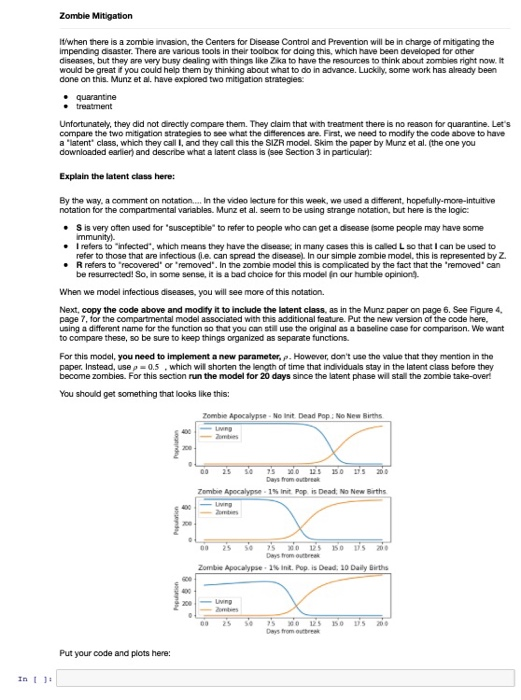Zombie Mitigation It/when there is a zomble invasion, the Centers for Disease Control and Prevention will be in charge of mitigating the impending disaster. There are various tools in their toolbax for daing this, which have been developed for other diseases, but they are very busy dealing with things like Zka to have the resources to think about zombies right now. It would be great if you could help them by thinking about what to do in advance. Luckily some work has already been done on this. Munz et al. have explored two mitigation strategies equarantine e treatment Unfortunately, they did not directly compare them. They claim that with treatment there is no reason for quarantine. Let's compare the two mitigation strategies to see what the diferences are. First, we need to modify the code above to have a "latent class, which they call I, and they call this the SIZR model. Skim the paper by Munz et al. (the one you downloaded eartlier) and describe what a latent class is (see Section 3 in particularj: Explain the latent class here: By the way. a comment on notation ln the v deo lecture for this week, we used a different, hopefully-more-intuitive notation for the compartmental variables. Munz et al. seem to be using strange notation, but here is the logic: .S is very often used for 'susceptible" to refer to people who can get a disease (some people may have some mmunity) I refers to "infected", which means they have the disease; in many cases this is called L so that I can be used to refer to those that are infectious (le. can spread the disease). In our simple zombie model, this is represented by Z - R refers to "recovered or 'removed. In the zombie model this is complicated by the fact that the 'removed can be resurrected! So, in some sense, it is a bad choice for this model (n our humble opinion. When we model infectious diseases, you will see more of this notation. Next, copy the code above and modity it to include the latent class, as in the Munz paper on page 6. See Figure 4. page 7, for the compartmental model associated with this additional teature. Put the new version of the code here using a different name for the function so that you can stlluse the original as a baseline case for comparison. We want to compare these, so be sure to keep things organized as separate functions. For this model, you need to implement a new parameter, p. However, don't use the value that thay mention in the paper. Instead, usep 0.5. which wil shorten the length of time that individuals stay in the latent class before they become zombies. For this section run the model for 20 days since the latent phase will stal the zombie take-over You should get something that looks like this: ombie Apecalypse-No init. Dead Pop: No New Births Zombies 00 2S 2.0 12 150 200 Zombie Apocalypse 1% nit Pop is Dead, No New Brths 00 25 5 Zombie Apocalypse-1% int. Pup is Dead, 10 Daily Births 00 25 50 12S 150 S 2 Deys from outbreek Put your code and plots here: Zombie Mitigation It/when there is a zomble invasion, the Centers for Disease Control and Prevention will be in charge of mitigating the impending disaster. There are various tools in their toolbax for daing this, which have been developed for other diseases, but they are very busy dealing with things like Zka to have the resources to think about zombies right now. It would be great if you could help them by thinking about what to do in advance. Luckily some work has already been done on this. Munz et al. have explored two mitigation strategies equarantine e treatment Unfortunately, they did not directly compare them. They claim that with treatment there is no reason for quarantine. Let's compare the two mitigation strategies to see what the diferences are. First, we need to modify the code above to have a "latent class, which they call I, and they call this the SIZR model. Skim the paper by Munz et al. (the one you downloaded eartlier) and describe what a latent class is (see Section 3 in particularj: Explain the latent class here: By the way. a comment on notation ln the v deo lecture for this week, we used a different, hopefully-more-intuitive notation for the compartmental variables. Munz et al. seem to be using strange notation, but here is the logic: .S is very often used for 'susceptible" to refer to people who can get a disease (some people may have some mmunity) I refers to "infected", which means they have the disease; in many cases this is called L so that I can be used to refer to those that are infectious (le. can spread the disease). In our simple zombie model, this is represented by Z - R refers to "recovered or 'removed. In the zombie model this is complicated by the fact that the 'removed can be resurrected! So, in some sense, it is a bad choice for this model (n our humble opinion. When we model infectious diseases, you will see more of this notation. Next, copy the code above and modity it to include the latent class, as in the Munz paper on page 6. See Figure 4. page 7, for the compartmental model associated with this additional teature. Put the new version of the code here using a different name for the function so that you can stlluse the original as a baseline case for comparison. We want to compare these, so be sure to keep things organized as separate functions. For this model, you need to implement a new parameter, p. However, don't use the value that thay mention in the paper. Instead, usep 0.5. which wil shorten the length of time that individuals stay in the latent class before they become zombies. For this section run the model for 20 days since the latent phase will stal the zombie take-over You should get something that looks like this: ombie Apecalypse-No init. Dead Pop: No New Births Zombies 00 2S 2.0 12 150 200 Zombie Apocalypse 1% nit Pop is Dead, No New Brths 00 25 5 Zombie Apocalypse-1% int. Pup is Dead, 10 Daily Births 00 25 50 12S 150 S 2 Deys from outbreek Put your code and plots here







